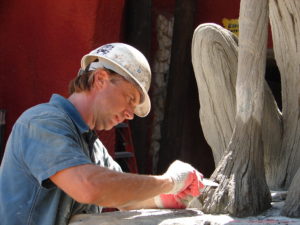
Most people don’t associate Lean practices with theming, but Bryan Campbell, a KHS&S art director, incorporates Lean into his daily work. From building dozens of mockups for improved bidding accuracy to incorporating material dry time into planning boards, including theming into Lean practices is crucial in order for KHS&S to meet tight production deadlines. Campbell works with the architects, owners and GCs to ensure the design intent of the project is achieved, often incorporating new materials, color washes and paints. He has successfully shown Lean processes are applicable to all types of projects, including art-driven ones.
Campbell follows the 5 S approach of Lean – Sort, Set, Shine, Standardize and Sustain – but with a slightly different approach geared toward theming.
Efficient Workflow Planning
With plaster, stucco and paint as the primary materials used in theming, each requires a different curing or drying time. By using planning boards, the team is able to sequence workflow avoiding a recently completed area. Work can be complete in other project areas, so nobody is idle waiting for materials to cure or dry.
Reducing movement of people and materials is achieved by staging supplies according to planned workflow as mixers, pumps and hoses are not easily mobile. Preordering materials, daily checklists of materials and preparing materials needed for next day also improve efficiencies.
“Cleaning as we go is essential to the Lean process because we have materials that interfere with access, can easily spill and create hazards,” added Campbell.
The Beauty of Mockups
Mockups are the core of art-related projects. While they are visual tools to show the final themed work, mockups narrow communication between art direction, client and craftspeople.
“We’re often working with architects and art directors which add another layer into the creativity process,” said Campbell. “Mockups help establish a baseline and holds clients and KHS&S accountable to what was agreed upon.”
Mockups help confirm estimates in production and identify necessary manpower and materials. Possible hurdles are discovered well before boots hit the ground.
Every project underway requires dozens of mockups be completed and signed off on in advance. Mockups range in scale from 6’ x 6’ double sided panels showing a plaster technique or paint finish to a 20’ x 20’ small scale water feature complete with landscape and final finishes.
During the mockup process, craftsmen are trained on new techniques to eliminate training on site and allows for experimentation to achieve the desired look.Waste is eliminated by trimming down processes without reducing quality while revealing ways to eliminate unnecessary steps or combine activities.
Undiscovered talent also emerges as craftsmen are challenged to work with new materials or complex designs. Many discover they have an affinity for artistic work and become a resource for future projects.
“Lean practices allow the GC to accelerate the project,” said Campbell. “Without the planning boards, mockups and other Lean tools, we would not be as successful in meeting the end date.”
